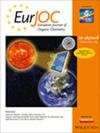Brønsted‐Acid Catalyzed Aldehyde Insertion to Construct C−X Bond: High Regio‐ and Chemoselectivity Synthesis of Dihydrobenzo[1,5]oxazocines and Pyrrolo[3,4‐ d]tetrahydropyrimidines
IF 2.5
3区 化学
Q2 CHEMISTRY, ORGANIC
引用次数: 0
Abstract
Aldehydes as one of the most widely building blocks, have been frequently utilized as privileged C1 electrophile units and exhibited versatile applications to construct carbon‐heteroatom and carbon‐carbon bond. We herein described a novel Brønsted‐acid catalyzed aldehydes insertion reaction with maleimide‐based 1, n‐C, O/N‐synthons, involving a high regio‐ and chemoselectivity [6/7 + 1]or [3 + 1 + 1 + 1]manner. The maleimide‐based 1, n‐C, O/N‐synthons (n = 3, 6, 7) were originally designed and developed by our group which were used as flexible bisnucleophiles. By this tandem annulations approach, two types of structurally diverse medium‐sized heterocycles were synthesized in good to excellent yields (74–91 %) and with excellent selectivity, including dihydrobenzo[1,5]oxazocines (24 examples) and pyrrolo[3,4‐ d]tetrahydropyrimidines (22 examples). Significantly, formaldehyde, long‐chain aliphatic aldehydes and aromatic aldehydes can act as C1 electrophile units catalyzed by racemic BINOL‐derived phosphoric acid catalyst in these transformations, which then selectively attacked the OH or NH group bearing in functionalized maleimides and underwent the formation of C−C, C−O or C−N bond in a short time under microwave irradiation conditions.

Brønsted-Acid催化醛插入构建C-X键:高区域选择性和化学选择性合成二氢苯并[1,5]恶唑嘧啶和吡咯[3,4-d]四氢嘧啶
醛作为最广泛的构建单元之一,经常被用作优越的C1亲电单元,并在构建碳杂原子和碳碳键方面具有广泛的应用。本文描述了一种新型br ønsted酸催化醛类与马来酰亚胺基1,n-C, O/ n-合子的插入反应,具有高区域选择性和化学选择性[6/7 + 1]或[3 + 1 + 1 + 1]。基于马来酰亚胺的1,n- c, O/ n- synthons (n = 3,6,7)最初是由本课课组设计和开发的,用作柔性亲核试剂。通过这种串联环法,以优异的收率(74-91%)和选择性合成了两种结构多样的中型杂环,包括二氢苯并[1,5]恶唑嘧啶(24例)和吡罗[3,4-d]四氢嘧啶(22例)。值得注意的是,甲醛、长链脂肪醛和芳香醛在外消旋binol衍生的磷酸催化剂的催化下,可以作为C1亲电单位,在微波照射条件下,选择性地攻击功能化马来酰亚胺中的OH或NH基团,并在短时间内形成C-C、C-O或C-N键。
本文章由计算机程序翻译,如有差异,请以英文原文为准。
求助全文
约1分钟内获得全文
求助全文
来源期刊
CiteScore
5.40
自引率
3.60%
发文量
752
审稿时长
1 months
期刊介绍:
The European Journal of Organic Chemistry (2019 ISI Impact Factor 2.889) publishes Full Papers, Communications, and Minireviews from the entire spectrum of synthetic organic, bioorganic and physical-organic chemistry. It is published on behalf of Chemistry Europe, an association of 16 European chemical societies.
The following journals have been merged to form two leading journals, the European Journal of Organic Chemistry and the European Journal of Inorganic Chemistry:
Liebigs Annalen
Bulletin des Sociétés Chimiques Belges
Bulletin de la Société Chimique de France
Gazzetta Chimica Italiana
Recueil des Travaux Chimiques des Pays-Bas
Anales de Química
Chimika Chronika
Revista Portuguesa de Química
ACH—Models in Chemistry
Polish Journal of Chemistry.

 求助内容:
求助内容: 应助结果提醒方式:
应助结果提醒方式:


